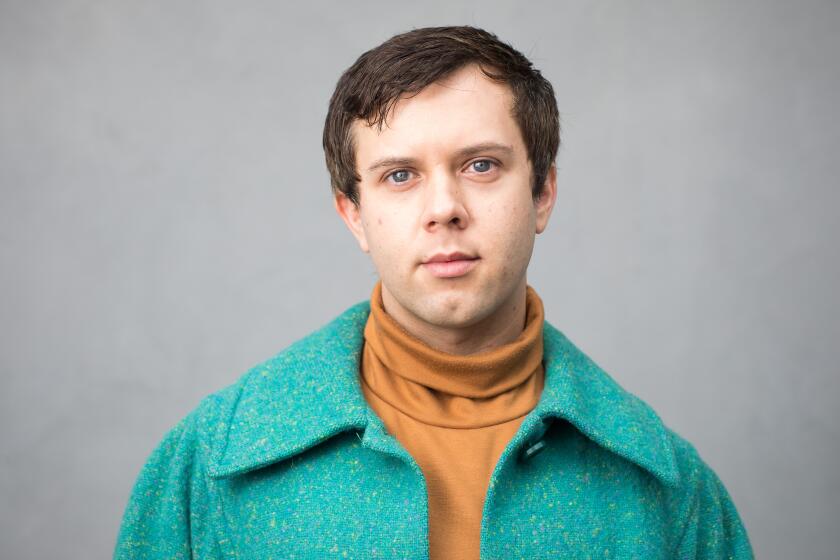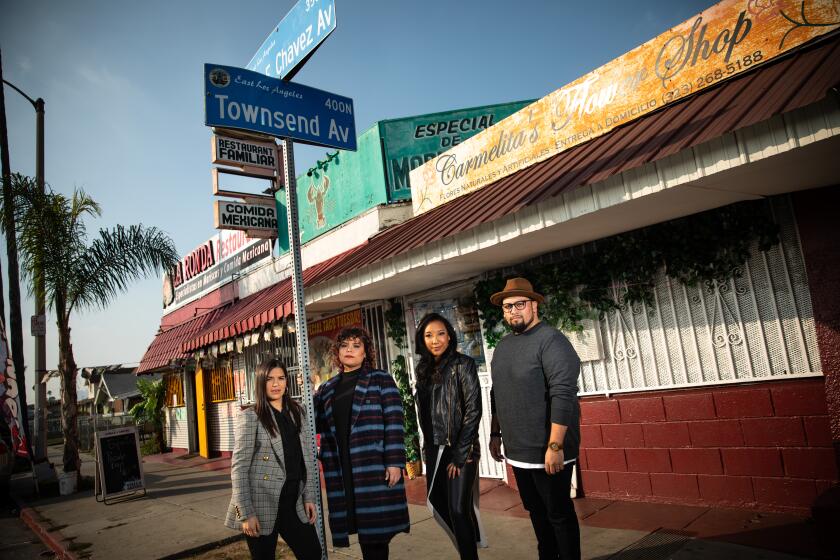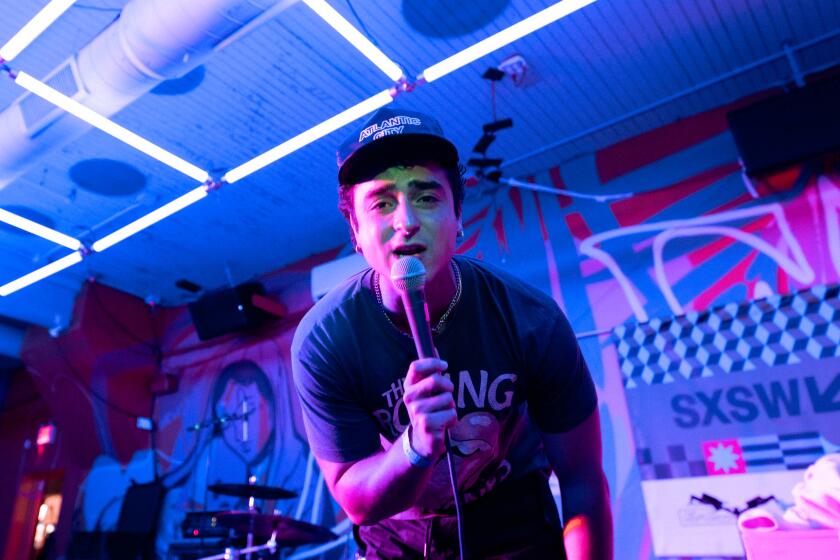Creators say TV festivals are transforming the industry. But not how you might think
- Share via
These days, you can watch television anywhere. On your TV, your tablet, your laptop, your phone. Even, at least in prepandemic times, at a movie theater.
Recent editions of the world’s preeminent film festivals have showcased a wealth of small-screen programming on the big screen. SXSW, whose (virtual) 2021 edition starts March 16, has hosted world-premiere events for such buzzy series as “Dear White People,” “Search Party,” “Mr. Robot” and “Ramy.” Tribeca Film Festival, which has for years hosted screenings and talks with TV creators — including the world premieres of “Chernobyl,” “The Boys” and “Genius” — began its own TV offshoot, the Tribeca TV Festival, starting with screenings of “Queen Sugar,” “Better Things” and “At Home with Amy Sedaris.” In recent years, attendees at the Toronto International Film Festival have been able to catch episodes of “Black Mirror,” “Transparent,” “The Deuce” and “Mrs. Fletcher,” while Sundance-goers have been able to boast a peek at titles like “I Love Dick,” “Finding Neverland” and “State of the Union” in between film screenings at Park City.
As conversations rage on about the blurring of the lines between film and television, there’s no denying that events designed to champion and celebrate cinema have warmly opened their doors to those working in episodic storytelling in recent years.
But beyond the presence of high-profile titles, the rise of TV at film festivals reflects the changing face of independent television development, from the boom of digital web series in the early 2010s to the current marketplace, which is liable to be shaped by the streaming wars for a decade to come.
The initial decision to include TV shows in the SXSW lineup was both an obvious and an organic one, said Janet Pierson, the Austin-based festival’s director of film. Early events with the likes of Lena Dunham (in 2012 with “Girls”) and Carlton Cuse (in 2013 with “Bates Motel”) led the way for the Episodic program that was launched in 2014. TIFF would follow suit in 2015 and Sundance in 2016, while Tribeca TV Festival arrived in fall 2017.
Just as independent filmmakers were grappling with a changing theatrical model that favored big-budget blockbusters and cable executives were hailing the arrival of Peak TV, Pierson and her peers saw a chance to embrace the bold work being done on the small screen, at times by the very people whose films they used to program (Dunham’s “Tiny Furniture,” for instance, had wowed SXSW audiences in 2010).
“No one wants a TV show more than Cole Escola,” Amy Sedaris says of the rising star, who once turned to sex work to make ends meet. “And they deserve it.”
“After a couple of years we just realized there was so much content being made, and made by filmmakers whose work we’ve seen or were aware of or were interested in, that we said, ‘Let’s try it and let’s see how it works,’” Pierson said. As with the rest of the festival, she noted, the focus remains on visionary work — the kind that often gets hailed as “cinematic” despite premiering on a network or a streaming service you can watch on your phone.
That’s exactly how Christina Lee, showrunner of the upcoming HBO Max series “Made for Love,” talks about her show’s compatibility with a venue like SXSW, which is premiering her pilot episode. “We just appreciate that they’re including television,” she said. “Because, you know, I think that we are, as creatives, approaching TV differently and really looking at the artistry of it. And so to be seen that way as well through these festivals is a real honor.”
One need look no further than the addition of television prizes at the 2021 Film Independent Spirit Awards to see pioneering TV projects as both an extension and a byproduct of the indie film world. This year’s inaugural nominee TV roster boasts series that bowed at various festivals around the world, including Amazon’s “Small Axe” anthology series (three episodes of which screened at New York Film Festival 2020), National Geographic’s docuseries “City So Real” (Sundance 2020), Showtime’s “Work in Progress” (Sundance 2019), HBO’s “We Are Who We Are” (San Sebastian Film Festival 2020, Cannes Directors’ Fortnight 2020) and Netflix’s “Unorthodox” (Séries Mania 2020).
But while those glitzy, network-stamped premieres at lauded fests tell a story of prestige TV being seen alongside the work of renowned auteurs from around the globe, there’s another aspect of festivals’ embrace of episodic storytelling.
At a time when the success of shows like “Insecure,” “High Maintenance,” “Broad City,” “Drunk History” and “Workaholics” was ushering in a new generation of storytellers who’d cut their teeth in the digital video space, these festival showcases led the way for pilot competitions, which have become a way for indie creators (often from underrepresented groups) to find platforms to connect with audiences, critics, collaborators and executives.
That was definitely the case for Marvin Lemus and Linda Yvette Chávez. Back in 2015, while working on branded video content and eager to be taken seriously, the pair began working on a web series focused on a Mexican-American family in Los Angeles. By the time “Gente-fied: The Digital Series” premiered at the 2017 Sundance Film Festival (where it arrived with the backing of MACRO and America Ferrera), Lemus and Chávez were already hard at work on their pitch to networks for a half-hour version of the series — which eventually landed at Netflix as “Gentefied.”
Netflix’s “Gentefied,” executive produced by America Ferrera, confronts gentrification in Boyle Heights. Can it avoid contributing to the problem?
The film festival space has emerged as a way to showcase work that reflects a new generation of storytellers who were all too happy to circumvent traditional models of television development in search of authentic stories. “I definitely look at it as another level of dismantling the gatekeepers and being able to kind of step in and be like, you know, we’re gonna work with what we got and we’re gonna still tell that story,” Lemus said.
Sameer Asad Gardezi, a WGA Award winner and founder-CEO of the IP incubator Break the Room, had a similar approach when he began developing what became “East of La Brea” (SXSW 2019). The web series, which focuses on two Muslim women in Los Angeles, benefited from a grant from the nonprofit Pop Culture Collaborative that allowed Gardezi to build a writers room (a then-unheard-of step for a show still in development) and, later, secure financial backing from Paul Feig’s digital content company, Powderkeg. The version of “East of La Brea” that played SXSW, released on Powderkeg’s Instagram in summer 2020, is both a sleek proof of concept (Gardezi is still developing “East of La Brea” into a half-hour series) and a signal example of a different way of developing TV content.
“The festival circuit, I think, is part of the puzzle,” Gardezi said. “But I think it’s part of a larger ecosystem of pipeline building and infrastructure building that I’ve been working on for the past three years.”
These experiences echo the expectations of creators showing work at this year’s SXSW Independent Pilot Competition. The promise of careful curation (SXSW is showing only six pilots in competition this year) and the ability to screen before a built-in audience are obvious perks for creators. But there are added expectations as well. Success stories in these spaces don’t always look like development deals or green lights.
For Kayla Lewis, screening “Parked in America,” her senior-thesis project about a Korean teenage girl, at SXSW is a rare chance to begin building herself a career in the television industry — anything from getting representation to meeting future collaborators. While at NYU’s Tisch School of the Arts she knew she wanted to make television. “But I don’t know how to break in, especially coming out of school and not really having any connections. Both my parents were in the food industry, so it’s not like I can just phone up my dad’s friend and be like, ‘Hey, hit me up.’”
In the case of Matt Kirsch and Julie Lake, the duo behind the horror comedy “Dale’s House,” SXSW was a logical next step for an indie project they knew they’d have to produce themselves in order to capture a tricky tone that may not have come across on the page or in a pitch deck. The two have seen firsthand how projects can remain in development hell for years while the festival route worked for projects like Rightor Doyle’s “Bonding,” which played at Canneseries, Frameline and L.A. Outfest before being picked up by Netflix.
The other shoe is always about to drop in Luca Guadagnino’s films, from the Oscar-nominated “Call Me by Your Name,” the last of his “Desire Trilogy,” to his latest HBO series, “We Are Who We Are.”
“We could have just put it up on YouTube and Facebook and Instagram, but I think it feels like festivals like SXSW really open the doors to put your project in front of [the] industry and buyers,” Lake explained. “YouTube and places like that are so oversaturated it’s harder to get attention.”
The need to focus that attention in a crowded entertainment landscape, and the proliferation of serial content that’s come with the streaming wars, may be driving the turn toward festivals that feature episodic storytelling almost exclusively, like Festival Séries Mania in Lille, France; SeriesFest in Denver; ATX Television Festival in Austin; Banff World Media Festival in Banff, Canada; the Monte-Carlo TV Festival in Monaco; and Stareable Fest in New York City.
Each of these has its own identity, from high-profile showcases — the scrapped 2020 edition of Séries Mania was to host screenings of 75 shows, from HBO’s “Westworld” to Amazon Prime Video’s “El Presidente” — to platforms for more home-grown fare — Stareable bills itself as “the largest community of web series creators and fans building the future of television through collaboration and discovery.” But all are meant to replicate for the television industry the very model of networking, talent discovery and deal-making that has dominated film festivals for decades, and move away from calcified development pipelines (pilot season, for instance) that are already in decline.
“People need content. And, you know, there’s lots of it out there and lots of great creators out there,” said Randi Kleiner, who launched SeriesFest with Kaily Smith Westbrook back in 2014. “We provide an access point.” The two have built their once weekend-long festival (now in its “seventh season”) into a year-round nonprofit organization that hosts pilot and scriptwriting competitions specifically focused on finding new talent from underserved communities.
For Ajay Kishore, founder of Stareable, the promise of these spaces lies in their ability to upend outdated ideas of who gets to make TV. “Particularly as a person of color, one of the things I find so exciting about web series and indie TV creators is that the groups that have traditionally been excluded by Hollywood — women, people of color, the LGBTQIA+, the disability community — thrive online because there are fewer gatekeepers.”
Watching TV episodes on the big screen at film festivals may never drive the cultural conversation in the way of a new Oscar contender emerging at Sundance or Cannes — or the water-cooler show of the moment. But the infrastructure being built around the screenings themselves is where the production, distribution and marketing of TV is now being reimagined.
“I think the powerful thing that’s happened over the past 10 years is that the internet has democratized who is allowed to be creative,” Kishore says. “And I think now we’re finally… taking that creativity and connecting it in a structured and smart way to the industry that’s hungry for it.”
More to Read
The complete guide to home viewing
Get Screen Gab for everything about the TV shows and streaming movies everyone’s talking about.
You may occasionally receive promotional content from the Los Angeles Times.








